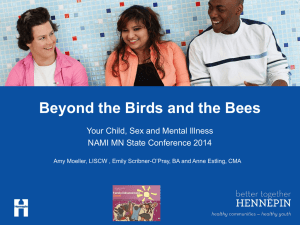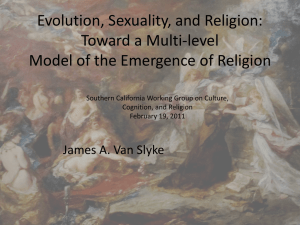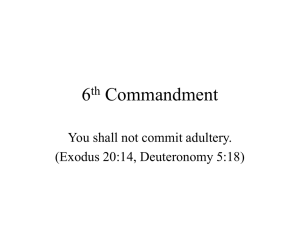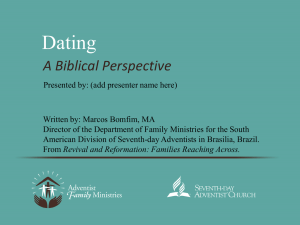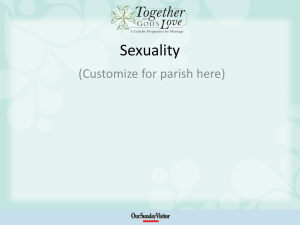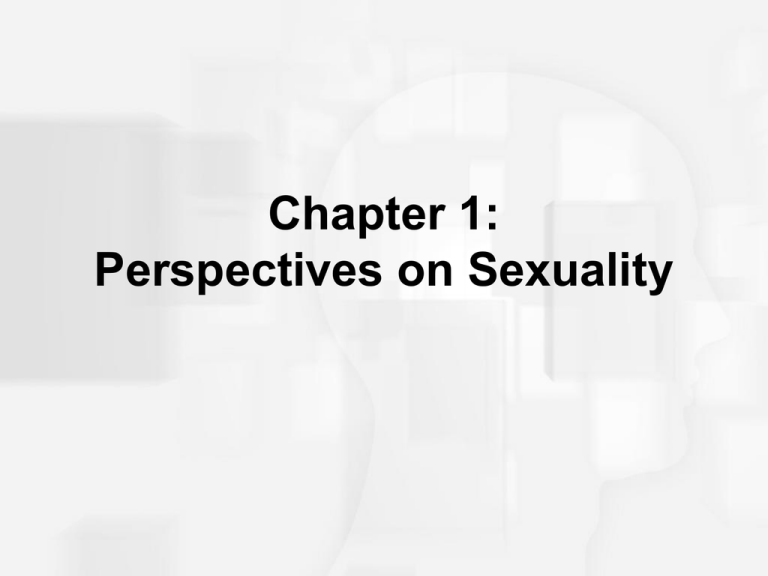
Chapter 1:
Perspectives on Sexuality
Controversy and Diversity
in Human Sexuality
Sexuality and the study of sexuality evokes strong
emotions and often much controversy:
• This course will look at all aspects of human
sexuality.
• We will be dealing with difficult and controversial
topics at times from a variety of perspectives.
What is Sexuality?
• A uniquely human trait
• More than just mating rituals
• Laws, customs, fantasies, art, music, etc.
What is Sex?
• Gender
– state of being male or female
• Sexual activities
– such as kissing, intercourse, or masturbation
• Anatomy
– structures that play a role in reproduction or
sexual pleasure
• Erotic
– feelings, experiences, or desires
Contradictory and Confusing
• Sexually “repressed” society surrounded by
sexual images
• Believe everyone is sexually active, yet an
uncomfortable discussion topic
• Explore our sexuality vs. moral restrictions
• Diversity in sexual expression
Class Exercise
• Make a list of all the places/sources where
you got information about sex when you were
growing up and as an adult.
• Identify:
– If the information was accurate
– Where you would have liked to gotten the
information from
Sexual Intelligence
• Four components of sexual intelligence:
– Understanding self
– Having interpersonal sexual skills and
integrity
– Obtaining accurate scientific sexual
knowledge
– Having consideration of the cultural context of
sexuality
• Increasing sexual intelligence will allow for
responsible decisions in sexual behavior
Course Goals:
Improving Sexual Intelligence
• Broad, accurate knowledge of sexuality
• Know society’s influences on our sexuality
• Identify trends, changes, and many other
influences affecting attitudes and behaviors
• Understand biological roots and social issues
related to sexuality
• Become more comfortable discussing sex
• Your personal goals
Studying Sexuality:
From a Biopsychosocial Orientation
A Psychosocial / Biopsychosocial Orientation
takes into account:
• Psychological factors
- Emotions, attitudes, motivations
• Social factors
- Process which we learn our social norms
• Biological factors
- Hormones, nervous system, genetics, etc.
Studying Sexuality:
Many Perspectives
The study of human sexuality draws upon the
scientific expertise of many different fields
including:
•
•
•
•
•
•
Anthropology
Biology
Medical Research
Sociology
Psychology
Public Health
Studying Sexuality
• The study of sexuality
• Sexologist – a person who engages in the
scientific study of sexual behavior
– Havelock Ellis (1859-1939)
– Richard von Krafft-Ebing (1840-1902)
– Sigmund Freud (1856-1939)
– Alfred Kinsey (1894-1956)
Values
• Studying human sexuality requires you to
explore your own values in order to fully
understand your decisions and attitudes.
• Expression of sexuality is a matter of choices.
Choices are dictated by value systems.
Value systems provide a framework for
judging the moral acceptability of sexual
options
Class Exercise
• What are your sexual values?
• Where did they come from?
Perspectives on
Human Sexuality
Perspectives on Human Sexuality
1.
2.
3.
4.
5.
6.
7.
Historical
Biological
Evolutionary
Cross-Species
Cross-Cultural
Sociocultural
Psychological
History of Sexuality
Hebrews
• Ancient Hebrews
– Gender roles highly specialized
– Sex within marriage a necessity
– Hebrew Bible had explicit rules
• Forbade adultery
• Forbade male homosexual intercourse
• Forbade incestuous relations
– Discussed sexual misconduct
– Stories of marital love
History of Sexuality
Ancient China
• Tao – the basic unity and interdependence of the
universe; comprised of two principles
– Yin: feminine, passive, inexhaustible
– Yang: masculine, assertive, limited
• Man should feed yang with prolonged contact with
yin, without ejaculation
• Female orgasm gave energy to yin
• Sexual instruction and manuals common
• Utilized drugs and sexual devices
History of Sexuality
India
•
•
•
•
Karma – cycle of birth and rebirth
Goal – live a just life, marry, procreate
Marriage – religious and economic obligation
Kamasutra – 3rd-4th century B.C.
– Nature of love
– Good family practices
– Moral guidance in love and sex
– Sexual techniques
History of Sexuality
Greece (1000 – 200 B.C.)
• More sexually permissive than the Hebrews
• Stories of sexual exploits, incest, rape, bestiality
• Distinguished between love and sex
– Aphrodite: goddess of sexual intercourse
– Eros: god of love
• Idealized men and the male form, as well as the
female form
• Sex was a symbol of power
History of Sexuality
Rome (5th to 7th Century B.C.)
• Marriage and sex were ways to improve
economic and social standing
• Passionate love almost nonexistent
• Few restrictions for early Romans
History of Sexuality
Early Christianity
• Jesus – liberal in thinking about sexuality, and its
punishment for transgressions
• Later followers established the dominant
western view of condemnation
– Spirituality through celibacy
– Sex outside of marriage as sinful; Sex for
procreation only
– Highest love is that for God
History of Sexuality
The Middle Ages
• From 1050-1150, sexuality was liberalized
• In 1215, church began confession and penance
• Women changed from a temptress (Eve) to a
model of virtue (Mary)
• Thomas Aquinas (1200s) argued sex organs
were for procreation; condemned homosexuality
• Late 15th century – campaign against witchcraft,
women’s insatiable “carnal lust”
History of Sexuality
The Reformation
• Protestantism – early 16th century
• Bible showed obligation to reproduce and have
marital love, instead of valuing celibacy
• Women were men’s partners in all things, not
just to have children
• Allowed divorce
• Companionship was focal in marriage
• Women were weaker than men
• Sex permissible only in marital union
History of Sexuality
The Enlightenment
•
•
•
•
18th century
Prized rational thought over traditional authority
Human nature best understood through study
Sexual reproduction was shown to be a great
evolutionary achievement
• “Free love” and rise in premarital pregnancy and
illegitimate births
• Homosexuality: condemnation and persecution,
then tolerance
History of Sexuality
Victorian Era
• Women’s role constrained; women as asexual
• Emotional & physical distance between husband and
wife
• Public behavior important, especially to the upper class
• Conservative sexual attitudes, not always practiced
• Prostitution flourished
• Continued polarized view of women: Madonna vs whore
• Mosher’s research contradicts prevailing view:
-Victorian women experienced sexual desire,
enjoyed intercourse, and experienced orgasm
In the late 19th and early 20th centuries, many doctors taught that masturbation was harmful, and so
devices, such as the two barbed rings and the shock box shown here, were created to keep childrenespecially boys-from achieving unwanted erections.
History of Sexuality
Sex in American History
•
•
•
•
The Colonies
United States – New World
19th century
20th century
History of Sexuality
The Colonies
• Puritans had severe sanctions for sexual
transgressions
• Sexuality was natural within marriage
• Bundling for young, courting couples
History of Sexuality
United States – New World
•
•
•
•
•
Church’s power diminished
Right to personal happiness, sexual liberation
Brothels, contraception, abortive medicines
Sexuality embraced within marriage, and without
Female indentured servants and slaves were
commonly raped
• Myth of slave promiscuity
• Sexuality of minorities was used to oppress
them
History of Sexuality
The 19th Century
• 1820s free love movement
• 1852 – Mormons announce practicing polygamy
• End of 19th century – Medical model of sexuality
– Women ruled by their wombs; ovarectomies
– John Kellogg’s sanitarium
– Homosexuality an illness, not a sin
• Comstock Act of 1873 – prohibited mailing
obscene writing or ads, including contraceptive
information and artwork containing nudity
History of Sexuality
20th Century Sexuality
• Social Movements:
–
–
–
–
Suffrage movement
Temperance movement
Civil rights movement
Lesbian & gay movement
• World War II:
– Roles were expanded & more flexible
– Postwar return to stricter roles
• 60’s & 70’s
– Feminism
– Sexual Revolution
– Research
Biological Perspective
• The roles of genes, hormones, the nervous
system, and other biological factors.
• Human sexuality is more than just the
physical process.
Evolutionary Perspective
Some individuals are better adapted to their
environment than others; those who are able to
adapt are more likely to survive and pass on their
genes.
• Evolutionary psychology – behavior patterns,
such as sexual behavior are genetically transmitted.
• Erotic plasticity – people showing different levels
of sexual desire in response to social and cultural
influences.
Cross-Species Perspective
• The examination of sexuality in other animal
species, placing human sexuality in a larger
context (i.e. male-female, male-male, and
kissing behaviors)
Cross-Cultural Perspective
• How do cultural beliefs affect sexual behavior
and people’s sense of morality?
• Among societies there are great
commonalities and differences in sexual
behavior.
Sociocultural Perspective
• Focuses on the differences in sexuality
among the subgroups of a society, such as
differences in religion, race, age, or gender.
Cultural Perspectives
• Variation among societies
• Variation within societies
• Major influences on sexual attitudes &
behaviors in all cultures:
– Socioeconomic status
– Education level
– Religion
– Ethnicity and/or nationality
– Gender
Cross-Cultural Perspectives
•
•
•
•
Islamic Middle East
Based on beliefs of Muhammad
Belief that sex should be enjoyed by both sexes
Women viewed inherently more sexual than
men (this power contained by veils, segregation,
female circumcision)
Oppression of women and many sexually
related restrictions stem from patriarchal cultural
traditions and fundamentalist sects, not from
religion and the teaching of the Qur’an
Cross-Cultural Perspectives
China
• Sexual conservatism with communist rule (1949)
– Lack of basic information about sexuality
– Sex outside of marriage and frequent sex within
marriage discouraged
– Almost no STDs
• Current trends
–
–
–
–
increasing rates of pre-marital sex
increasing STDs
slightly more open to homosexuality
still lack sexual knowledge and safe-sex skills
Psychological Perspective
• Psychological influences: perception, learning,
motivation, emotions and personality.
– Sigmund Freud and psychoanalytic theory – we
internalize conflicts between sexuality and society.
How we resolve the conflicts determines our ability to
love and work.
– Learning theories – environmental factors help
shape behavior (rewards and punishments)
– Social-Learning – behaviors are determined through
learning theories, but also through observational and
cognitive experiences.
The Media and Sexuality
How have mass media reflected and influenced
sexual norms?
What are elements unique to sexuality on the
Internet compared with other mass media?
The Media and Sexuality
• Television
– News, advice, and educational programs
– Increased access to sexual material
• Percentages of sexual content
– Cable and music videos
– Video games
– Determining of social norms
• Advertising (Man’s last stand, woman’s last stand)
• Magazines
Sexual Taboos and Television
Cyberspace and Sexuality
• 1.5 billion Internet users worldwide
• 80% of people obtain health information from
Internet
• Source of sexual expression
• MySpace, Facebook, Twitter
• Availability on hand held devices
– PDA, iPod, Cell phones
Sexuality
Where the Personal is Political
• Impact of social norms
• Freedoms and responsibilities today
• Controversies facing human sexuality
How can something as personal as sex be
political?



